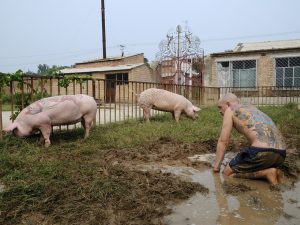TIM is a work by Belgian artist Wim Delvoye that sold for over 100,000 euros in 2008. The work took approximately 40 hours to complete and has been showcased in museums around the world including the Louvre and MONA. TIM is a tattoo. For now, a man named Tim Steiner is the frame for TIM. When Tim dies his skin will be peeled off, stretched, and cured. TIM will need a new frame. Until then Tim Steiner will be displayed shirtless in various museums around the world. In exchange for his skin and his time, Tim was paid one third of TIM’s selling price. As far as Tim has expressed in interviews, he is okay with this arrangement.
“When I die my skin will be removed, framed and given to the owner at that time. Of all the things that have to do with this piece, that aspect interests me the least. I’m dead. No longer here. Who cares. I’m an organ donor and my back is just skin. I used to find it cool that I’ll be remembered, but Wim will be remembered, not me. It’s a Wim Delvoye work, not a Tim Steiner. And that’s just fine.”

It seems as if Tim’s position as Delvoye canvas and frame provides some sense of purpose. Tim’s situation may force him to confront the knowledge of his death in a very direct way, but perhaps this confrontation helps him accept death to some degree. There is also a way in which Tim’s position as an instrument of Delvoye’s work can be seen as a dedication to a purpose larger than his self. Even if he says otherwise, the knowledge that his skin will be maintained on display long after his death may provide Tim with a sense of having a lasting effect on the world
.
Beyond speculation of Tim’s individual experience, TIM is also a way for Delvoye to orchestrate a performance of social relations. In regard to Delvoye’s hope for a future resale of TIM, Tim says, “Wim would like a resale at some point. Secondary market with auction and profit. The whole shebang. Really take the concept to the extreme. Wim wants me to be a ‘Lot’ and have people in suits bidding on my living skin.” Other than simply inflating the value of his work, it is unclear what Delvoye is trying to achieve by orchestrating this absurd auction. A theme throughout Delvoye’s work is that it makes us confront the disgusting, meaningless and animalistic elements of our existence. For instance, one of his works, “Cloaca” is an elaborate device that simply processes food into feces. Another piece, “Art Farm,” is a farm populated by tattooed pigs. By subjecting pigs to a form of body modification typically reserved for humans, Delvoye inflicts the viewer with some sense of identification with the tattooed pigs. Perhaps this auction is a way to display an ugly, competitive and animalistic side of human behavior, thinly sanitized by wealth and ritual.

To me, there is something viscerally disgusting about the purchase of someone’s skin as a canvas to be skinned and preserved upon death. However, as someone with no belief in life after death, there should not be any reason for me to care about what happens to my body after I die. Within this non-believing worldview, there is no reason why one shouldn’t sell one’s corpse. After all, the sum of money that Tim received likely benefited him in his current life, and whatever happens to his corpse won’t affect his experience. If I accept this logic but still would not sell my corpse, then perhaps my disbelief is deceptive. I do not think I am alone in holding these contradictory views. If one maintains any level of concern over how one’s body is treated after death, then perhaps one does not truly believe that death is the end of experience.
Sources:
https://wimdelvoye.be/
http://www.smithjournal.com.au/blogs/arts/meet-tattoo-tim
Recent Comments